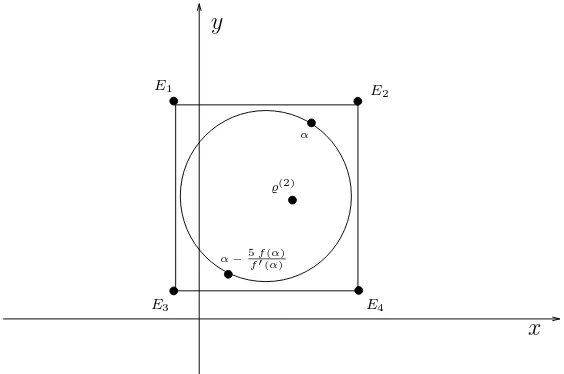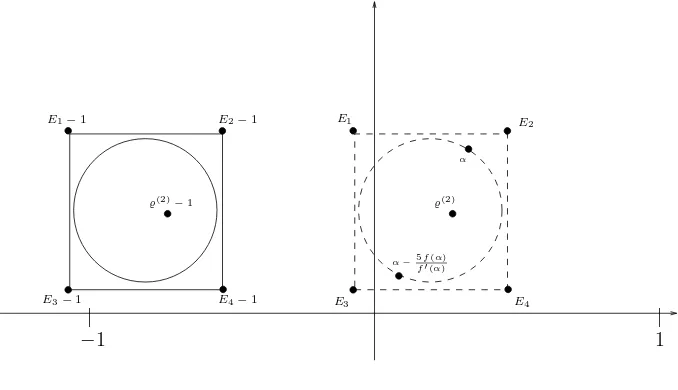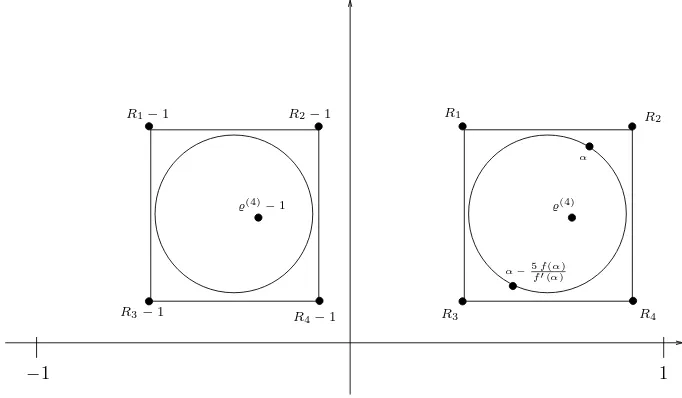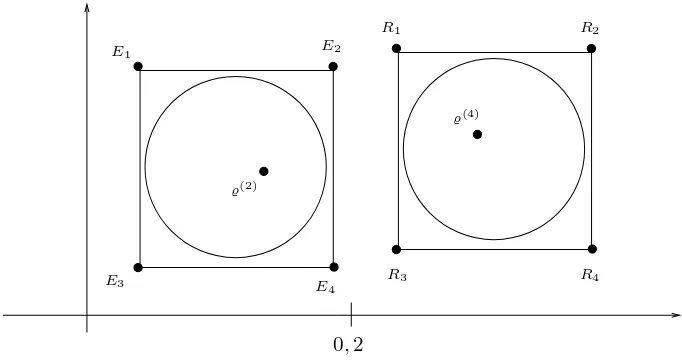de Bordeaux 18(2006), 693–706
Fundamental units in a parametric family of not
totally real quintic number fields
parAndreas M. SCH ¨OPP
Dedicated to Michael E. Pohst on the occasion of his 60th birthday.
R´esum´e. Dans cet article, nous donnons des unit´es fondamen-tales pour une famille de corps de nombres engendr´es par un polynˆome param´etr´e de degr´e 5 avec signature (1,2) et groupe de GaloisD5.
Abstract. In this article we compute fundamental units for a family of number fields generated by a parametric polynomial of degree 5 with signature (1,2) and Galois groupD5.
1. Introduction
Let K be a number field generated by a zero ρ of a monic irreducible polynomialf ∈Z[x]. LetnKbe the degree ofK andrKthe unit rank ofK.
The computation of the unit group of an order ofK can be done by several methods like the Voronoi algorithm (for rK ≤ 2), successive minima and
other geometric methods using parallelotopes and ellipsoids. Iff defines a parametric family of polynomials it is a problem to give the fundamental units ofK in a parametric form, in particular for increasing degreenK and
rankrK. For degreesnK ≤3 there are parametric systems of fundamental
units known for several families of number fields of different unit rank (see for example [2] for unit rank 1 and degree nK = 2 and nK = 3, and [19],
[23], [8] forrK = 2 withnK = 3).
In the case nK = 4 Stender ([21], [22]) has obtained families with unit
rank 2. Some families with unit rank 3 are described in the biquadratic case ([20], [3], [6], [25]) and in the non-biquadratic case ([13]). FornK = 5
only a few families of number fields with explicit systems of fundamental units are known (see [12] for 2 families of degree 5 and rank 2 and 3, and see [17]). The parametric unit computation has been extended up to number fields of degree 8 with cyclic Galois group by Shen ([18]) or with Galois group isomorphic toC2×C2×C2 by Wang ([24]).
In [9] we have constructed parametric polynomials fn(x) of degree n
with Galois group either the dihedral group Dn of order 2n, or the cyclic
group Cn of order n using elliptic curves with rational points of order n.
For n = 4 we computed in [10] parametric units which form a system of fundamental units under some conditions. The constructed polynomial f5(x) is isomorphic to the one of Brumer (for details see [9]). Kihel showed
in [7] that any set of four roots of this polynomial forms (under certain conditions) a fundamental system of units of the splitting field.
In this article we compute parametric units in the casenK = 5. We use a
geometric observation and a Theorem of Obreschkoff. The computed units are fundamental for signature (1,2) under some conditions. This is proven by approximations of the complex roots of the generating polynomials.
2. The Polynomial Pn(x) Forn∈Zwe consider the polynomials
Pn,b,5(x) =x5−n x4+b(2n+b2−b−1)x3−b2(n+b−3)x2+b3(b−3)x+b4
introduced in [9] and [16]. We only consider the case b = ±1. Since Pn,−1,5(x) = Pn+5,1,5(x + 1), we consider only the case b = 1, and set
Pn(x) =Pn,1,5(x) =x5−n x4+ (2n−1)x3−(n−2)x2−2x+ 1.These
polynomials have discriminant 16(4n3−28n2+ 24n−47)2, and are irre-ducible for every choice of n∈ Z which is shown by a short computation modulo 2.
Lemma 2.1. The polynomials Pn(x) (with b= 1) have signature(1,2)for
n≤6 and signature (5,0) for n≥7.
Proof. The discriminant is positive for every n ∈ Z which implies that Pn(x) have exactly one or five real roots. We havePn(−1) =−4n+ 5<0
forn≥ 2 and Pn(0) =Pn(1) = 1>0. Moreover Pn(12) = −2n32+13 < 0 for
n≥7, hence there are at least three real roots for n≥7.
In the case n < 7 we compute the signature (2,1) with the help of a theorem of Sturm (in algorithmic version for example in H. Cohen [1], 4.1.10+4.1.11): Let l0 be the leading coefficient of A0 = Pn (thus l0 =
1), l1 the leading coefficient of the derivation A1 = P
′
n (thus l1 = 5).
For a polynomial divison of Ai−2(x) by Ai−1(x) in the form Ai−2(x) =
Ai−1(x)Qi(x)−Ai(x), letli(n) be the leading coefficient of the rests Ai(x)
for 2 ≤ i ≤ 5. Then a computation yields (apart from positive constant factors and quadratic denominators)
l2(n) = 2n2−10n+ 5, l3(n) =n4−4n3−14n2+ 6n−22,
and
l5(n) = (n4−4n3−14n2+ 6n−22)2.
Let ω(n) be the number of sign changes in the following sequence which depends onn−l0, l1,−l2(n), l3(n),−l4(n), l5(n). And letν(n) be the
num-ber of sign changes inl0, l1, l2(n), l3(n), l4(n), l5(n). Then givesω(n)−ν(n)
the number of real roots of Pn(x). For every n < 7 we get ω(n) = 3 and
ν(n) = 2 (even if the specific sequences differ).
3. The Galois group of Pn(x)
The Galois group of Pn(x) over Q(n, b) is the dihedral group with 10
elements as shown in [9], Th´eor`eme 2.
Lemma 3.1. For b = 1 the polynomials Pn(x) have only for n ∈ {7,18}
the Galois group C5; both polynomials generate the same number field.
Proof. Geißler gives in [4] a condition for polynomials to have cyclic Galois group: the expression P5
i=1xix2i+1 have to be rational for the roots xi of
Pn(x). This is equivalent to the existence of rational points on certain
elliptic curves (quotient curves) as shown in [9]. For Pn(x) this quotient
elliptic curve is
z2 = 4n3+(b2−30b+1)n2−2b(3b+1) (4b−7)n−b(4b4−4b3−40b2+91b−4) and withb= 1 we havez2 = 4n3−28n2+ 24n−47. With the computer algebra systemMAGMA[11] we compute the Mordell-Weil group overQto Z/5Zwhere all finite points haven-coordinate 7 or 18. Therefore only the polynomials
P7(x) =x5−7x4+ 13x3−5x2−2x+ 1,
and
P18(x) =x5−18x4+ 35x3−16x2−2x+ 1
have the Galois groupC5. With the computer algebra systemKANT[5] it is
easy to show that for a rootρofP7(x) the algebraic number 2ρ3−9ρ2+2ρ+1
is a root of P18(x).
4. Parametric units
By Lemma 2.1 for n≤6 the number fields K generated by Pn(x) have
two fundamental units. SincePn(x) =x(x−1)(x3−(n−1)x2+n x+2)+1, ρ
and ρ−1 are units inK.1
Theorem 4.1. The elementsρ, ρ−1build a system of independent units in the equation orderZ[ρ]. Moreover they are fundamental in Z[ρ]for n <6.
Remark. In the casen= 6 the units ρ and ρ−1 are independent which is proved by KANT [5]. They don’t generate the full unit group of Z[ρ]. The set{2ρ4−11ρ3+ 16ρ2+ 2ρ−4, ρ4−5ρ3+ 6ρ2+ 3ρ−2} is a system
of fundamental units. The equation order is maximal in this case.
The proof of this theorem needs an approximation of the absolute values of the considered elements ρ and ρ−1 and of their conjugates. Since ρ is a root ofPn(x) its conjugates are the other roots.
Lemma 4.2. Let n≥7. Letρ(1), ρ(2), ρ(3), ρ(4) andρ(5) be the real roots of Pn(x). Then we have the following approximations:
−1<−√1
we have the inequalities:
Pn(−√1n−n1) = −2n
For n≤6 we have to find approximations of the absolute values of the complex roots. For this we use the following theorem of Obreschkoff [14]:
Lemma 4.3 ([14], page 9). Let f(x) be a polynomial of degree m and α an arbitrary complex number with f(α) 6= 0 and f′(α) 6= 0. Then there is
With this Lemma we show the following result.
Lemma 4.4. Let ρ(1) be the real root and let ρ(2)=ρ(3), ρ(4) =ρ(5) be the
pairs of complex roots of Pn(x) (with b= 1). Then we have the following
approximations:
(i) −n+ 2 + 2 n <|ρ
(1)
|<−n+ 2 + 1
n for n <−4
(ii) −n+ 3 + 2 n <|ρ
(1)−1|<−n+ 3 + 1
n for n <−4
(iii) 1
2√−n <|ρ
(2)
|< √2
−n for n <−4
(iv)
r
1− 3 4n <|ρ
(2)−1|<
r
1− 6
5n for n <−144
(v)
r
1 +3 n <|ρ
(4)|<
r
1− 1
n2 for n <−174
(vi)
r
−65n <|ρ(4)−1|<
r
−1314n for n <−139
Proof. The following considerations are for n < −4. Since n is negative it will be easier to substitute n by −n. Thus we study the polynomial resulting fromPn(x)
f(x) =x5+n x4−(2n+ 1)x3+ (n+ 2)x2−2x+ 1 and its roots̺(1), . . . , ̺(5).
Again, the real root is found by looking for a sign change. The determi-nation of the position of the complex roots is laborious: With Lemma 4.3 we construct a circle around one root of a pair of complex roots. Around the circle we put a square whose corners will give an approximation of the absolute value of the root.
(i)+(ii) Real rootρ(1) of Pn(x):
For the real root̺(1) of f(x) we have
−n−2 + 1 n < ̺
(1)<
−n−2 + 2 n, because of the inequalities
f(−n−2 + 1 n) =
−n8 −2n7
+17n6
+43n5 −16n4
−42n3
+35n2 −10n+1
n5 <0
and
f(−n−2 + 2 n) =
8n7
+48n6
+37n5 −156n4
−48n3
+248n2
−160n+32
forn >4. The Approximation for|ρ(1)|and for |ρ(1)−1|follows.
(iii) First pair of complex rootsρ(2)=ρ(3) of P
n(x):
For an approximation of the roots̺(2) =̺(3)off(x) with Lemma 4.3 we
choose α = 21n2 + √i
n forn >4. For these nwe have 0<ℜ(α),ℑ(α) <1.
It isf(α)6= 0 andf′(α)6= 0. The real part of 5f(α)
f′(α) is
5(96n16 −16n15
+48n14
−240n13
+78n12
+27n11 −16n10
+78n9
+...) 4n2
(16n17
+64n16
+32n15
+48n14
+16n13
+76n12
+112n11 −13n10
+149n9
+...)
and the imaginary part is
5(16n16
+32n15
+20n14
+48n13 −8n12
+104n11 −29n10
+38n9
+...) 2√n(16n17+64n16+32n15+48n14+16n13+76n12+112n11
−13n10+149n9+...).
For all n >4 we have 0<ℑ(α−5ff′((αα)))<1. For 4< n≤10 the complex numberα−5ff′((αα)) lies in the second quadrant with−1<ℜ(α−
5f(α)
f′(α))<0. Forn >10 we have 0<ℜ(α−5ff′((αα)))<1.
Let C be the circle through α and α− 5ff′((αα)) with exact diameter
5f(α)
f′(α) forn > 4. The root ̺(1) lies not inside and not on the circle (since it lies
close to−n−2). Lemma 4.3 shows that there is (at least) one root̺(2) of f(x) inside the circle C. To find an approximation of the distance of ̺(2)
to the origin we construct a square aroundC.
E3 E4
α−5ff′((αα))
E2 E1
α
̺(2)
x y
The center of the circle isα−25ff′((αα)). Starting there we construct the corners of the square. Since the inequality
holds for the square of the diameter of the circle for all n > 2, it follows that the radius of the circle is less then 4√n(5n+1). With this we compute the corners of the square as
α− 5f(α)
Moreover the signs of the coefficients show that the distance from E1 to
the origin is less than the distance of E2 to the origin. Therefore we get
the following approximation for|̺(2)|:
|ℑ(E3)|< which holds for alln >4 and with the approximation (forn >4)
|E2|=
we remark that the translation by −1
changes only the real part which makes things a little bit more complicated than for real roots.
The corners of the square E1, . . . E4 lie close2 to the origin. Therefore
the translation of̺(2) by −1 yields the situation shown in Figure 2.
2For alln >4 the inequality 0<ℜ(Ei)<1 holds fori= 2,4 and−1<ℜ(Ej)<0 holds for
α−5ff′((αα))
α
1
E3 E4
E2 E1
̺(2) ̺(2)−1
−1
E1−1 E2−1
E4−1
E3−1
Figure 2. Approximation of ̺(2)−1
Now all new corners E1−1, . . . E4−1 lie in the second quadrant and we
get the approximation
|E1−1|>
̺
(2)−1
>|E4−1|.
The computation yields the inequalities
|E1−1|=
(4n2,−55n19+2n18,5+...
(n+1)(n17
+4n16
+...)−1)2+ (
4n18
+20n17
+...
4√n(n+1)(n17+4n16...))2
(1/2)
<
r
1 + 6 5n forn >144 and
|E4−1|=
(4n2,55n19+2n18,5+...
(n+1)(n17
+4n16
+...)−1)2+ (
4n18
+10n17
+...
4√n(n+1)(n17+4n16+...))2
(1/2)
>
r
1 + 3 4n
forn >141. The assertion for ρ(2)−1 follows.
(v) Second pair of complex roots ρ(4) =ρ(5) of P
n(x):
The approximation of the roots ̺(4) = ̺(5) of f(x) is analogue to the
preceding approximation. In this case we chose α= 1−n1 +n32 +√i
n and
again we havef(α)6= 06=f′(α). The real part of 5f(α)
f′(α) is
−5 (2n17 −99n16
+269n15
−1653n14
+4000n13
−14112n12
+27794n11
−68041n10
+...)
n2
(4n17
+24n16
+68n15
+457n14
−496n13
+6296n12
−10300n11
+36408n10
and the imaginary part is in the first quadrant. As before the real and the imaginary part are both smaller than 1.
Again we construct a circle C and an enclosing square with corners R1, . . . R4. We get the approximation of the diameter of the circle
All corners lie in the first quadrant3 forn >10. An approximation for ̺(4) is therefore
Forn >174 we get the approximation
|R2|=
and for n >49 the approximation
|R3|=
Hence the assertion forρ(4) follows. (vi) The translated number ρ(4)−1:
1
−1
α−5f(α) f′(α)
α
̺(4) ̺(4)−1
R1−1 R2−1
R3−1 R
4−1
R1
R3
R2
R4
Figure 3. Approximation of ̺(4) and ̺(4)−1
For the approximation of̺(4)−1 the observationℜ(R
i)<1 for 1≤i≤4
is helpful: this is why all cornersR1−1, . . . R4−1 lie in the second quadrant
(see figure 3) and we have
|R1−1|>
̺
(4)−1
>|R4−1|.
We get the inequality
|R1−1|=
(nn2020,,55+5n19,5−...
+6n19,5
+...−1)2+ ( n18
+6n17
+47n16
... n18,5
+6n17,5
+17n16,5
...)2 (1/2)
<q1314n
forn >54, and the inequality
|R4−1|=
(nn2020,,55+5n19,5+...
+6n19,5
+...−1)2+ (
2n18 −13n17
−...
2n18,5
+12n17,5
+...)2 (1/2)
>
q
5 6n
forn >139. Hence the assertion for ρ(4) follows. (vii) Position of ̺(2) and ̺(4):
Finally we have to show that̺(2) and ̺(4) (and therewith ρ(2) andρ(4)) are different. This is because of the position of the roots (the first one close to 0 and the second one close to 1) or rather of the position of the enclosing squares.
Consider first the square belonging to the numberα= 21n2 +√i
n: The real
part of the right upper corner E2 is (more exactly than before)
ℜ(E2) = 5n
19
+2n18,5
+20n18 −5n17,5
+10n17 −1
2n 16,5
+15n16
+5n15,5
+...+ 25 1024
√
n
4n2,5(n+1)(n17+4n16+2n15+3n14+n13+19 4 n
12+7n11+...+ 25 1024)
E1
E3
̺(4)
̺(2)
E2
E4
0,2
R1
R3
R2
R4
Figure 4. Position of the roots ̺(2) and ̺(4) in the first quadrant
For the second square belonging to the number α = 1−n1 +n32 +√i
n the
real part of the left upper corner R1 is (more exactly than before)
ℜ(R1) = ( 4n19
+20n18
−25n17,5
+61n17
−150n16,5
+427 2 n
16
+...+492075 2 )
n2
(4n17
+24n16
+68n15
+457n14 −496n13
+6296n12
+...−437400n+164025).
For these real parts we have ℜ(E2) < 51 <ℜ(R1) for all n >4. Hence we
have the situation as shown in figure 4.4 This implies that both squares are disjoint and that the roots̺(2)and̺(4)differ. So Lemma 4.4 is proven.
With these approximations we know the position of the five roots of Pn(x) for n ≥ 7 (see Lemma 4.2) and for n ≤ −175 (see Lemma 4.4)
sufficiently to prove Theorem 4.1.
Proof of Theorem 4.1. First we considern≥7. To show the independence of the units ρ and ρ−1 we assume their dependance in the form ρk =
±(ρ−1)lwithk, l∈Z. If this equality holds then it holds for all conjugates too in particular forρ(1) and ρ(3). With the approximations in Lemma 4.2
we have|ρ(1)|<1<|ρ(1)−1|and|ρ(3)−1|< 25 < 35 <|ρ(3)|<1. Letk >0. The inequality for the first conjugate impliesl >0 while the inequality for the third conjugate impliesl <0. Hence there is no lwithρk=±(ρ−1)l. Analogue considerations yield a contradiction fork <0. Hence the units ρ andρ−1 are independent for n≥7.
Now we consider n ≤ −175. In this case by theorem 2.1 there are one real and two pair of complex roots. Suppose ρk = ±(ρ −1)l with
k, l ∈ Z. By Lemma 4.4 we have 0 < |ρ(2)| < 1 < |ρ(2) −1| < 2 and
0 < |ρ(4) −1| < |ρ(4)| < 1; for k > 0 this implies l < 0 for the second
conjugates and l > 0 for the forth conjugates. For k < 0 an analogue argumentation yields a contradiction too.
To prove the fundamentality of these units in the equation orderZ[ρ] we compute an upper and a lower approximation of the regulator. Since field extensionQ(ρ)/Qgenerated by Pn(x) has no intermediate fields and since
|disc(Z[ρ])|= 16(4n3−28n2+ 24n−47)2 >55 for n≤ −175 we use the lower regulator bound given by Pohst/Zassenhaus ([15], 5.6.22)
Reg(Z[ρ])≥
An upper regulator bound is computed with the help of the approxima-tions ofρ(1) and ρ(4) given in lemma 4.4: get the upper regulator bound
Reg(Z[ρ])≤
which is simplified withn≤ −175 to
≤
The quotient Ro
The independency and the fundamentality of the units ρ and ρ−1 in the equation orderZ[ρ] for −174≤n < 6 are shown by calculations with
KANT[5].
Acknowledgment: We would like to thank the referee for insightful comments and suggestions.
References
[1] H. Cohen,A Course in Computational Algebraic Number Theory. (Graduate Texts in Math-ematics138), Springer, 1993.
[2] G. Degert, Uber die Bestimmung der Grundeinheit gewisser reell-quadratischer Zahl-¨ k¨orper. Abh. Math. Sem. Univ. Hamburg22(1958), 92–97.
[3] G. Frei,Fundamental systems of units in number fieldsQ(√D2+d,√D2+ 4d)withd |D.
Arch. Math. (Basel)36.2(1981), 137–144.
[4] K. Geissler,Berechnung von Galoisgruppen ¨uber Zahl- und Funktionenk¨orpern. Thesis TU Berlin (2003).
[5] KANT: http://www.math.tu-berlin.de/ kant
[6] S. Katayama,Theabcconjecture, fundamental units and the simultaneous Pell equations. Proc. Jangieon Math. Soc.1(2000), 19–26.
[7] O. Kihel,Groupe des unit´es pour des extensions di´edrales complexes de degr´e 10 surQ. J. Th´eor. Nombres Bordx.13.2(2001), 469–482.
[8] Y. Kishi, A family of cyclic cubic polynomials whose roots are systems of fundamental units. J. Number Theory102.1(2003), 90–106.
[9] F. Lepr´evost, M.E. Pohst, A.M. Sch¨opp,Familles de polynˆomes li´ees aux courbes mod-ulairesX0(l)unicursales et points rationnels non-triviaux de courbes elliptiques quotient.
Acta Arith.110.4(2003), 401–410.
[10] F. Lepr´evost, M.E. Pohst, A.M. Sch¨opp,Units in some parametric families of quartic fields. To appear in Acta Arithm. (2007).
[11] MAGMA: http://magma.maths.usyd.edu.au
[12] E. Maus, Zur Arithmetik einiger Serien nichtaufl¨osbarer Gleichungen 5. Grades. Abh. Math. Semin. Univ. Hamb.54(1984), 227–250.
[13] K. Nakamula,Certain Quartic Fields with Small RegulatorsJ. Number Theory57(1996),
1–21.
[14] N. Obreschkoff,Verteilung und Berechnung der Nullstellen reeller Polynome. (Hochschul-b¨ucher f¨ur Mathematik55), Dt. Verlag der Wissenschaften, 1963.
[15] M.E. Pohst, H.J. Zassenhaus, Algorithmic algebraic number theory, (Encyclopedia of Mathematics and its applications), Cambridge University Press, 1997.
[16] A.M. Sch¨opp,Uber Torsionspunkte elliptischer und hyperelliptischer Kurven nebst Anwen-¨ dungen. Thesis TU Berlin (2005).
[17] R. Schoof, L.C. Washington,Quintic polynomials and real cyclotomic fields with large class numbers. Math. Comput.50.182(1988), 543–556.
[18] Y.-Y. Shen,Unit groups and class numbers of real cyclic octic fields. Trans. Am. Math. Soc.
326.1(1991), 179–209.
[19] H.-J. Stender,Einheiten f¨ur eine allgemeine Klasse total reeller algebraischer Zahlk¨orper. J. Reine Angew. Math.257(1972), 151–178.
[20] H.-J. Stender, Grundeinheiten f¨ur einige unendliche Klassen reiner biquadratischer Zahlk¨orper mit einer Anwendung auf die diophantische Gleichungx4
−ay4
=±c(c= 1,2,4
oder8). J. Reine Angew. Math.264(1973), 207–220.
[21] H.-J. Stender,Eine Formel f¨ur Grundeinheiten in reinen algebraischen Zahlk¨orpern drit-ten, vierten und sechsten Grades. J. Number Theory7(1975), 235–250.
[23] E. Thomas, Fundamental units for orders in certain cubic number fields. J. Reine Angew. Math.310(1979), 33–55.
[24] K. Wang, X. Zhang,Fundamental unit system and class number for real number field of type (2,2,2). Tsinghua Sci. Technol.5.2(2000), 150–153.
[25] K. Wang,Fundamental unit systems and class number of real bicyclic biquadratic number fields. Proc. Japan Acad. Ser. A Math. Sci.77.9(2001), 147–150.
Andreas M.Sch¨opp
Technische Universit¨at Berlin Straße des 17. Juni 136, 10623 Berlin, Germany



